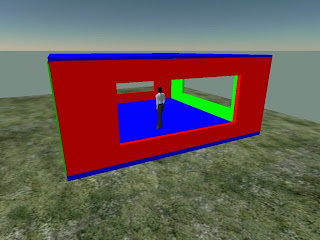
You can use the door described at previous point and one of the wall described in the simple room, then using various cut and pasting you can "make a hole" where the door is.
making a hole means that you have to restrict and duplicate the red wall (for instance) to be at least a 3 part structure:
The section over the door (.7x10x.2) 0,270,0
The section on the left of the door (3.5x1.5x.2) 0,270,0
The section on the right of the door (3.5x6.4x.2) 0,270,0 (You can hollow this 60 to have extra window).
You can link together the pieces of the wall but NOT the door. (UNLUCKILY)






